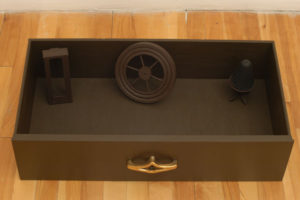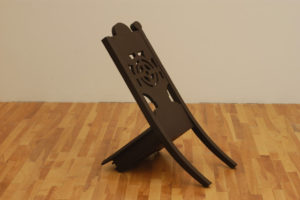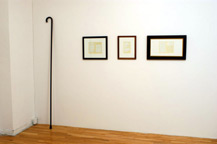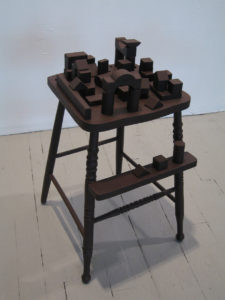Since 2000, John Latour has worked with vintage found objects as the basis for his sculpture. Drawn to the sense of history these objects evoke, he recognizes that their individual histories have been lost. For much of his sculptural practice, a recognizable object is made unfamiliar, strange or non-functional through simple modifications.
In 2009, the artist has taken a new direction in his research. Instead of trying to connect with the past, he’s exploring the idea of communicating with the past. In particular, he’s investigating the links between sculpture and spirit communications (the belief that one can communicate with disincarnate beings). Photo: Tanya St-Pierre
Depuis 2000, John Latour sert des objets trouvés d’époque à la base de ses sculptures. Il est attiré par le sens de l’historique que ces objets évoquent, même s’il sait que leurs histoires individuelles ont été perdues. Dans la plupart de sa pratique sculpturale, un objet reconnaissable est rendu inconnu, étrange, ou non-fonctionnel par des simples modifications.
En 2009, l’artiste a pris une nouvelle piste de recherche. Au lieu d’essayer d’entretenir des liens avec le passé, il voulait explorer l’idée de la communication avec le passé. En particulier, il a voulu explorer les liens entre la sculpture et la communication spirite (la croyance qu’on peut communiquer avec les entités désincarnés). Photo : Tanya St-Pierre
Selection / Sélection
A Temporary Haunt for Wandering Spirits (2023)
In-situ installation using materials found on-site at Pierre-François Ouellette art contemporain (Montreal) / Installation in situ utilisant des matériaux trouves sur place à Pierre-François Ouellette art contemporain (Montréal)
Variable dimensions / Dimensions variables
A Temporary Haunt for Wandering Spirits (2023)
In-situ installation using materials found on-site at Five Years gallery (London, UK) / Installation in situ utilisant des matériaux trouves sur place à la galerie d’art Five Years (Londres, G.-B.)
Variable dimensions / Dimensions variables
Sweetheart Spirit Board (2015)
Found object (wooden ironing board), acrylic paint, form, metal casters, pencil
Objet trouvé (planche à repasser en bois), peinture acrylique, formulaire, roulettes en métal, crayon.
Variable dimensions / Dimensions variables
This collaborative drawing project, installation and publication is based on the tradition of the Ouija board and spiritoscopes. Participants are invited to hold onto the planchette, think of someone from the past, and ask them a question. Using the planchette as a drawing device, participants may draw a response directly onto the Ouija form. They are able to share their results by pinning their form on a nearby wall.
Ce projet, publication et installation collaborative est inspiré par la tradition du Ouija et des spiritoscopes. Les participants sont invités à tenir la planchette, à penser à quelqu’un du passé et à lui poser une question. En se servant la planchette comme outil de dessin, les participants dessinent une réponse directement sur le formulaire Ouija. Ils peuvent partager leur résultat en épinglant leur formulaire sur un mur adjacent.
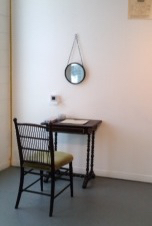 Â
 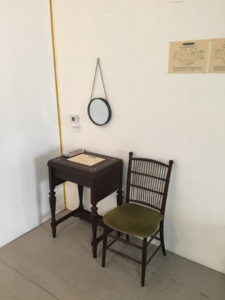 Â
 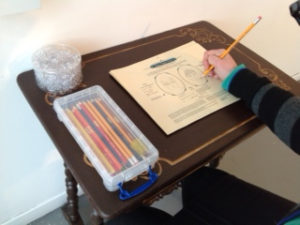
The Chair Test / Le test de la chaise I + II (2013-2014 + 2015)
Found objects (wooden chairs and tables), acrylic paint, questionnaires, digital clocks, mirrors, pencils, measuring tapes
Objets trouvés (chaises et tables en bois), peinture acrylique, questionnaires, horloges digitale, miroirs, crayons, rubans de mesurement
Variable dimensions / Dimensions variables
.
This participatory art project invites viewers to test their precognitive ability (the ability to see into the future) through art. It draws inspiration from the history of paranormal research. In the traditional chair test, an individual selects a chair at random from a group of chairs to be used at an upcoming public function. He or she is then asked to describe the person who, unknown to them, will eventually attend the public function and occupy the chair. Their description is compared to the sitter. If the description corresponds well to that person, then one can infer that the test subject has demonstrated a capacity to see into the future.
The test has been modified and simplified for a contemporary art context. A chair should be installed in a gallery and accompanied by a questionnaire. Participants are asked to sit in the chair, and describe themselves by answering a short series of questions. They will also be asked to envision the next person to occupy the chair and to answer a short number of questions about that unknown individual. Each test sheet will provide a space for the individual to draw a portrait of themselves as well as the next occupant of the chair.
Upon completing their assignment, each participant is asked to record the date and time of their involvement in the project on the test sheet, and to pin it on a nearby wall in the exhibition. The public will be able to view and compare all of the sheets in chronological order to determine how well sitters were able to predict the future.
Ce travail participatif invite les spectateurs à tester leurs capacités prémonitoires (la capacité d’entrevoir l’avenir) à travers l’art. Il s’agit d’un projet qui s’inspire de l’histoire de la recherche paranormale. Dans un « test de la chaise » traditionnel, un individu choisit une chaise au hasard dans un groupe de chaises pour être utilisée lors d’une activité publique à venir. Il ou elle est ensuite invité à décrire la personne qui, à son insu, finira par assister à cette activité publique et occuper la chaise. Sa description est comparée avec la personne qui occupera la chaise après. Si la description correspond bien avec cette personne, on peut inférer que le sujet du test a démontré une capacité à entrevoir l’avenir.
Le test a été modifié et simplifié pour être présenté dans le contexte d’une exposition d’art contemporain. Une chaise est installé dans une galerie et accompagnée d’une questionnaire à compléter. Les participants sont invités à s’assoir dans le fauteuil et à se décrire en répondant à une courte série de questions. Ils sont également invités à imaginer la prochaine personne qui occupera le fauteuil et à répondre à une courte série de questions sur cette personne inconnue. Chaque questionnaire offre un espace pour que l’individu puisse dessiner son autoportrait et un espace pour dessiner le prochain occupant de la chaise.
À l’issue de ce travail, chaque participant est invité à enregistrer la date et l’heure de son implication dans le projet sur le questionnaire et à l’épingler sur un mur dans la galerie. Le public sera alors en mesure de visualiser et de comparer tous les questionnaires dans l’ordre chronologique afin de déterminer comment les participants ont prédit l’avenir.
Long ago (2013)
Found object (brass horn), fishing line, vinyl lettering
Objet trouvé (cornet en laiton), ligne à pêche, lettrage en vinyle
Variable dimensions / Dimensions variables
edition of 2 / édition de 2
text(e):
“Long ago I wrote that there was twilight in my cell and twilight in my heart, but this is the (last?) twilight of the soul. In eternal twilight I move, but I know that in the world there is day and night, seedtime and harvest and red sunset must follow apple green dawn. ” Oscar Wilde1
1Oscar Wilde (Spirit), through the mediumship of Mrs. Travers Smith, “Circle of Expiation” in Arthur Conan Doyle, comp., The Spiritualists’ Reader: A Collection of Spirit Messages from Many Sources, Specially Prepared for Short Readings, Manchester, Two Worlds’ Publishing, 1924, p. 105.
Apports (2010-2014)
Found objects, wood, metal, paraffin wax, acrylic paint
Objets trouvés, bois, métal, cire de paraffine, peinture acrylique
Variable dimensions / Dimensions variables
This selection of small sculptures is based on vintage found objects and is related to the phenomenon of apportation – ordinary or transformed objects that materialize out of thin air during the course of séances. Apports, drawn from the French verb “apporter” (“to carry”) are believed to have been brought over from the other side by visiting spirits. There are 17 apports in this series that were produced from 2010 to 2014.
Cette sélection de petites sculptures réalisées à partir d’objets d’époque trouvés se réfèrent au phénomène d’apportation – le matérialisation d’objets ordinaires ou transformés au cour de séances de spiritisme. Les apports, du verbe « apporter », nous parviendraient de l’au-delà par l’entremise des esprits visiteurs. Cette série comprend 17 apports du 2010 à 2014.
Apports 11 à 14 (2012)
Found objects, wood, metal, paraffin wax, acrylic paint
Objets trouvés, bois, métal, cire de paraffine, peinture acrylique
Variable dimensions / Dimensions variables
A set of four sculptures from the Apport series with vintage found objects (a horseshoe, a compass, a pipe and a pocket diary from 1946).
Une suite de quatre sculptures de la série Apports avec des objets d’époque trouvés (un fer à cheval, une boussole, une pipe et un journal intime de poche de 1946)
Spirit radio (2009-2010)
Found object (vintage railway cap), copper wire, paraffin, alligator clips, earphone, paper clip, diode, capacitor, resistor
Objet trouvé (vieille casquette de cheminot), fil de cuivre, cire de paraffine, pinces crocodile, écouteur, trombone, diode, condensateur, résistance
28 x 28 x 15 cm
This hand-held sculpture combines an old railway cap with crystal radio technology from the 1920s and onwards. It can receive radio signals.
Cette sculpture portative combine une vieille casquette de cheminot avec des éléments d’une radio cristal (basée sur une technologie accessible au public depuis les années 1920). Elle est capable de recevoir des signaux radio.
Psychic cabinet (2010)
Found objects (wooden cabinet and foot rest), copper pipes and wire, plastic shower curtains, acrylic paint
Objets trouvés (armoire en bois et repose-pieds), tuyau et fils en cuivre, rideau de douche en plastique, peinture acrylique
cabinet /armoire : 184 x 68 x 51 cm
curtain / rideau : 193 x 188 x 193 cm
This sculpture is based on the tradition of spirit cabinets – enclosed spaces created from furniture and curtains that were used by mediums of the late nineteenth and early twentieth century to focus their psychic powers. Traditionally, these cabinets are used before or during séances. The Psychic cabinet provides the occupant with a private shelter to collect their own mental energies.
Cette sculpture est inspirée de la tradition des cabinets de voyance – des espaces clos créés à l’aide de mobiliers et de rideaux, où les médiums à la fin du dix-neuvième siècle et au début du vingtième siècle pouvaient se concentrer pour mieux exercer leurs pouvoirs psychiques. Traditionnellement, ces cabinets étaient utilisés avant ou durant les séances de spiritisme. Le Psychic cabinet offre à l’occupant un espace privé où recueillir ses propres images mentales.
The Visitor / Le Visiteur (2009)
Found objects (wooden table, iron, chandelier, horn, megaphone, wrench, pulley, glass jug), metal cable, acrylic paint, soundtrack
Objets trouvés (table en bois, fer, chandelier, corne, porte-voix, clé anglaise, poulie, pichet en verre), câble en métal, peinture acrylique, bande sonore
Variable dimensions /Dimensions variables
A large wooden table with eight legs forms the centre of this sculpture. The table, a found object, hangs in the air and is encircled by eight other found objects. Each smaller piece is attached to one of the legs of the table by a metal cable (or a thread) that reaches up to the ceiling. Like the table, each of the eight objects is suspended in mid-air. The weight of the table is the same as the combined weight of all the other objects. In this way, the sculpture hangs in a state of equilibrium.
The Visitor combines three elements that are traditionally associated with séances: a levitating table; small floating objects; and the faint sound of music coming from no discernible source. This work includes a minimalist soundtrack that lasts for ten minutes. The soundtrack is a musical recording from the 1920s. The original song has been modified and is no longer recognizable (see download option below).
Au centre de cette sculpture se trouve une grande table en bois à huit pattes. La table, un objet trouvé, est suspendue et entourée par huit autres objets trouvés d’époque. Chaque petit élément est attaché à l’une des pattes de la table par un câble métallique (ou un fil) qui descend du plafond. Comme la table, chacun des huit objets est suspendu dans l’air. La masse de la table est égale à la masse de tous les autres objets ensemble. Dans cette optique, la sculpture flotte dans un état d’équilibre.
Le Visiteur comprend trois éléments traditionnellement associés avec les séances : une table en lévitation, des petits objets qui flottent en l’air, et un faible et inexplicable bruit de musique. L’œuvre intègre une bande sonore minimaliste qui dure dix minutes. Cette bande sonore est tirée d’un enregistrement musical du début des années 1920. La chanson d’origine a été modifiée et n’est plus reconnaissable.
Download excerpt (5 min.) of soundtrack / Téléchargez un extrait (5 min.) de la bande sonore ici : mp3
Creative Commons CC BY-NC-ND (Attribution-NonCommercial-NoDerivs / Paternité Pas d’Utilisation Commerciale-Pas de Modification)
Time machine 2 (2009)
Found object (vintage clock), contemporary mechanism and glass, metallic and acrylic paint
Objet trouvé (horloge d’époque), verre et mécanisme contemporains, peinture métallique et acrylique
53 x 27 x 13 cm
Time machine 2 is a modified clock from the 1920s or 1930s. Although it is operational, attentive viewers will remark that its hands move in a slow and deliberate counter-clockwise direction. As if through some form of wish-fulfillment, this clock from the past appears to turn time backwards.
Time machine 2 (Machine à remonter le temps 2) est une horloge modifiée datant les années 1920 ou 1930. Bien qu’elle soit fonctionelle, les spectateurs attentifs remarqueront que ses aguiles tournent lentement et délibérément en sens inverse. Un peu comme si elle exauçait un souhait, cette horloge du passé semble inverser la direction du temps.
Time machine 1 (2008)
Found object (vintage clock), contemporary mechanism and glass, metallic and acrylic paint
Objet trouvé (horloge d’époque), verre et mécanisme contemporains, peinture métallique et acrylique
23 x 44 x 13 cm
Time machine 1 (like Time machine 2) is a modified clock from the 1920s or 1930s. Its hands also move in a counter-clockwise direction as if to turn back time.
Time machine 1 (comme Time machine 2) est une horloge modifiée datant les années 1920 ou 1930. Ses aguiles tournent lentement en sens inverse un peu comme si elle semble inverser la direction du temps.
I became a shelter (2007)
Found object (wooden table), hinges, printed text on paper, acrylic paint
Objet trouvé (table en bois), charnières, texte imprimé sur papier, peinture acrylique
sculpture: 80 x 70 x 41 cm
page: 20.5 x 12.4 cm
I lullaby (2007)
Found objects (wooden lamp and baby’s carriage, child’s umbrella), shoelaces, printed text on paper, acrylic paint
Objets trouvés (lampe et poussette en bois, parapluie d’enfant), lacets, texte imprimé sur papier, peinture acrylique
variable dimensions / dimensions variables
Crawlspace (2002)
Found object (wooden chest of drawers), acrylic paint
Objet trouvé (commode en bois), peinture acrylique
102 x 72 x 43 cm
Photo: Paul Litherland
Untitled 1-4 / Sans titre 1-4
Found objects (wooden drawers), acrylic paint, various objects
Objets trouvés (tiroirs en bois), peinture acrylique, objets divers
17 x 67.5 x 35 cm each / chaque
Untitled / Sans titre (2002)
Found object (wooden chair), and acrylic paint
Objet trouvé (chaise en bois), peinture acrylique
81.5 x 49.5 x 66 cm
Fragile (2002)
Found object (wooden cane), wood, acrylic paint / Objet trouvé (canne en bois), bois, peinture acrylique
204 x 15 x 3 cm
Edition of 3 / édition de 3
1. Private collection / Collection privée
2. City of Ottawa Fine Art Collection / Collection de la Ville d’Ottawa, 2003-0027
3. Collection of the artist / Collection de l’artiste
La rue des anglais (2000)
Found object (wooden high chair), wooden building blocks, acrylic paint /
Objet trouvé (chaise d’enfant en bois), blocs de construction en bois, peinture acrylique
74 x 45 x 49 cm
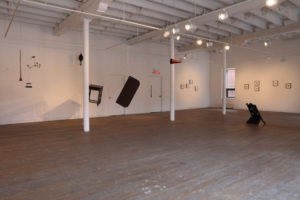
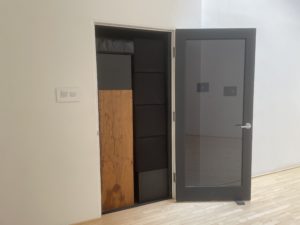
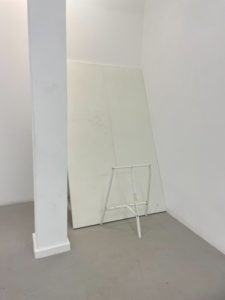
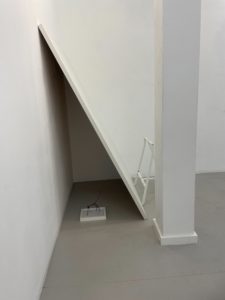
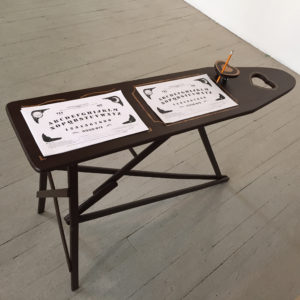
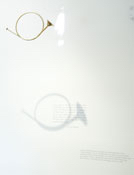
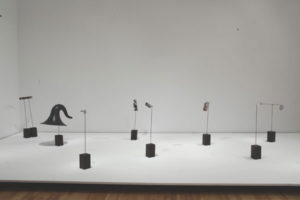
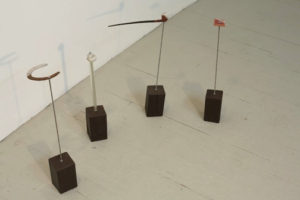
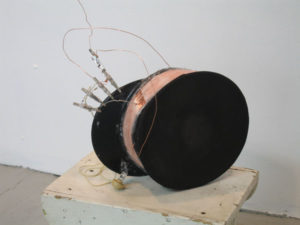
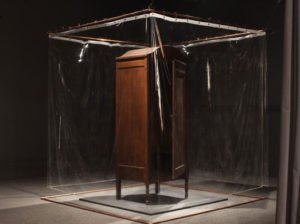
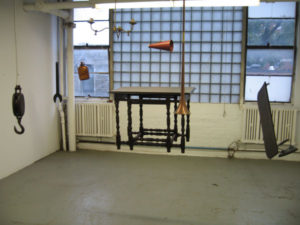
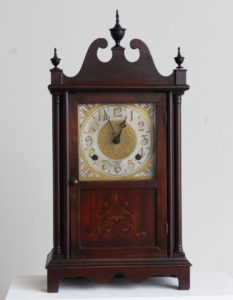
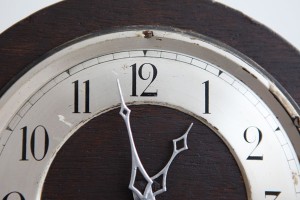
 Â
 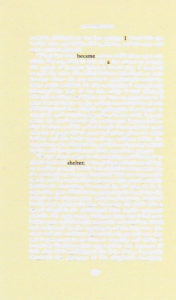
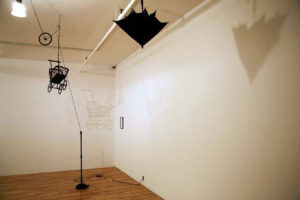
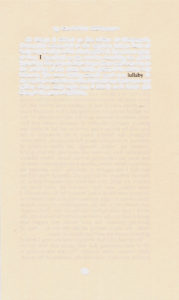
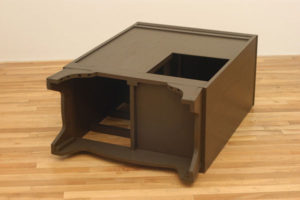
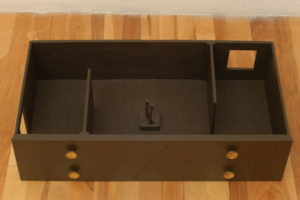
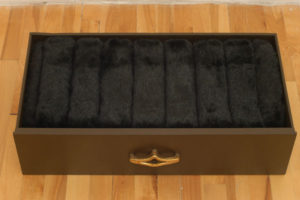
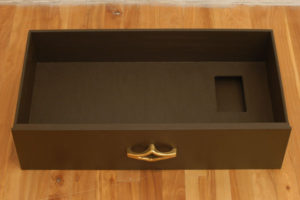 Â
 